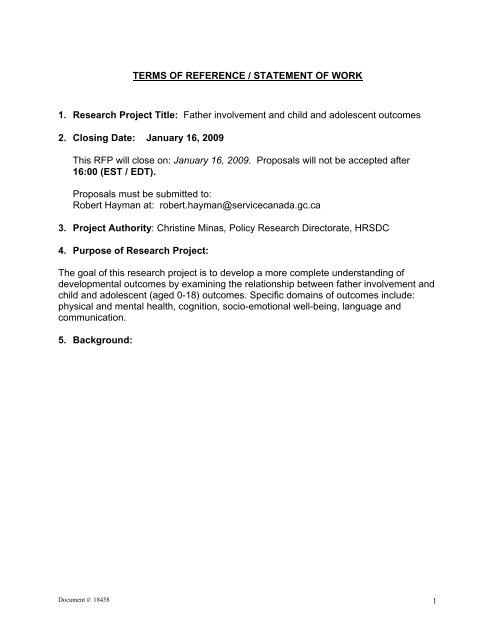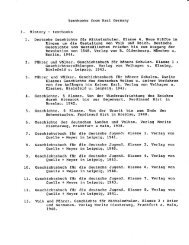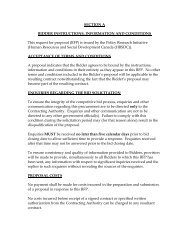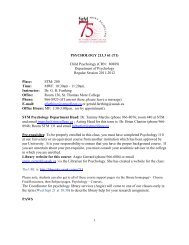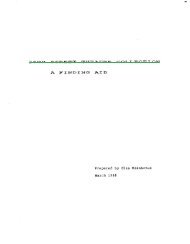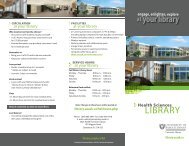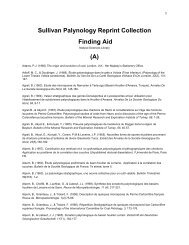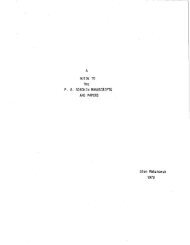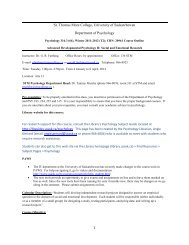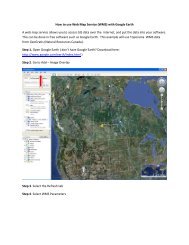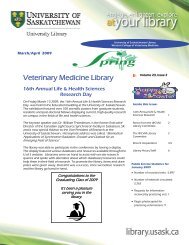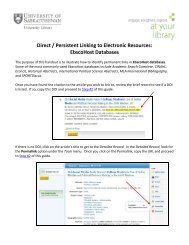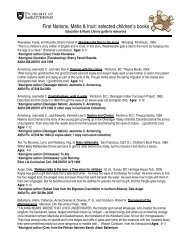Father involvement and child and adolescent ... - University Library
Father involvement and child and adolescent ... - University Library
Father involvement and child and adolescent ... - University Library
Create successful ePaper yourself
Turn your PDF publications into a flip-book with our unique Google optimized e-Paper software.
Document #: 18458<br />
TERMS OF REFERENCE / STATEMENT OF WORK<br />
1. Research Project Title: <strong>Father</strong> <strong>involvement</strong> <strong>and</strong> <strong>child</strong> <strong>and</strong> <strong>adolescent</strong> outcomes<br />
2. Closing Date: January 16, 2009<br />
This RFP will close on: January 16, 2009. Proposals will not be accepted after<br />
16:00 (EST / EDT).<br />
Proposals must be submitted to:<br />
Robert Hayman at: robert.hayman@servicecanada.gc.ca<br />
3. Project Authority: Christine Minas, Policy Research Directorate, HRSDC<br />
4. Purpose of Research Project:<br />
The goal of this research project is to develop a more complete underst<strong>and</strong>ing of<br />
developmental outcomes by examining the relationship between father <strong>involvement</strong> <strong>and</strong><br />
<strong>child</strong> <strong>and</strong> <strong>adolescent</strong> (aged 0-18) outcomes. Specific domains of outcomes include:<br />
physical <strong>and</strong> mental health, cognition, socio-emotional well-being, language <strong>and</strong><br />
communication.<br />
5. Background:<br />
1
What we know about <strong>child</strong>ren <strong>and</strong> <strong>adolescent</strong>s, aged from birth to 18, in Canada is<br />
based, to a large extent, on the mother-<strong>child</strong> interaction. Despite significant research<br />
interest in the environments, especially families, in which <strong>child</strong>ren are raised, most<br />
examinations of <strong>child</strong> development have focused on the centrality of the mother-<strong>child</strong><br />
relationship, while essentially ignoring the father-<strong>child</strong> relationship. In fact, much of the<br />
underst<strong>and</strong>ing of parental influences has remained at the level of limited indicators,<br />
such as income <strong>and</strong> educational attainment. Where more in-depth parental<br />
characteristics <strong>and</strong> behaviour are incorporated into models, the paradigm is very much<br />
centered on the mother. This skewed view of parental influence has been questioned in<br />
more recent research in the United States <strong>and</strong> other national contexts (Waldfogel,<br />
2006).<br />
The literature in this area uses the term “father <strong>involvement</strong>” or “fathering” to describe<br />
fathers’ interactions with their <strong>child</strong>ren <strong>and</strong> the impact of that interaction on<br />
developmental outcomes (Lamb, 1981; Lamb et al., 1985; Pleck et al., 1985). <strong>Father</strong><br />
<strong>involvement</strong> occurs throughout a <strong>child</strong>’s life <strong>and</strong> is not limited to the early years (e.g. 0-<br />
6). Components of father <strong>involvement</strong> include, but are not limited to, positive<br />
engagement, warmth-responsiveness, control-monitoring, participation, <strong>and</strong> knowledge<br />
sharing.<br />
Much of the current knowledge of <strong>child</strong> <strong>and</strong> <strong>adolescent</strong> development in Canada is<br />
based primarily on two sources: (1) mothers’ accounts of <strong>child</strong>ren’s characteristics <strong>and</strong><br />
behaviour, <strong>and</strong> (2) direct assessments on <strong>child</strong>ren (e.g. PPVT, Who am I, number<br />
knowledge). While it may have been the case that mothers’ accounts were found to be<br />
more reliable due to closer observation <strong>and</strong> time spent with the <strong>child</strong>, to date, very little<br />
information both within Canada <strong>and</strong> internationally on <strong>child</strong> <strong>and</strong> <strong>adolescent</strong> development<br />
is based on fathers’ accounts. One reason for this situation in Canada is because the<br />
National Longitudinal Survey of Children <strong>and</strong> Youth (NLSCY) 1 collects information on<br />
<strong>child</strong>ren from the person most knowledgeable (PMK) who for the majority of cases, is<br />
the biological mother of the <strong>child</strong>. In over nine out of ten cases this is the individual who<br />
provides the information. Thus, we do not know how fathers report on their <strong>child</strong>ren’s<br />
development as well as their interaction with them.<br />
Our current underst<strong>and</strong>ing of <strong>child</strong> development is also problematic because analyses<br />
of factors associated with <strong>child</strong> development overly-focus on the mother’s<br />
characteristics, style <strong>and</strong> practices (e.g. educational attainment, engagement,<br />
breastfeeding, health <strong>and</strong> lifestyle behavior, etc). Moreover, little information is collected<br />
on fathers themselves. Such an approach has provided an incomplete underst<strong>and</strong>ing of<br />
the environments in which <strong>child</strong>ren are raised (i.e. Coté et, al, 2007).<br />
Public policy <strong>and</strong> academic knowledge in the area of fathers <strong>and</strong> <strong>child</strong> development in<br />
Canada represents a significant research gap. Although there are studies of this<br />
1<br />
http://www.statcan.ca/cgibin/imdb/p2SV.pl?Function=getSurvey&SDDS=4450&lang=en&db=IMDB&dbg=f&adm=8&dis=2http://www.statcan.ca/cgibin/imdb/p2SV_f.pl?Function=getSurvey&SDDS=4450&lang=en&db=IMDB&dbg=f&adm=8&dis<br />
=<br />
Document #: 18458<br />
2
elationship in other contexts, such as the United States, for example the Fragile<br />
Families 2 project (Lewin-Bizan, 2006; Waller, 2007), this area remains relatively<br />
unexplored in Canada.<br />
Two recent developments make this area particularly salient at this time. First, there has<br />
been an increase in the number of lone fathers in Canada, up from 62,000 in 1981 to<br />
119,000 in 2001 (Galameau, 2005). In 2001, lone fathers accounted for approximately<br />
one in six lone parent families. And second, since the introduction of the new parental<br />
leave policy in the province of Quebec in January 2006, 56% of eligible men have taken<br />
paternal leave after the birth of their <strong>child</strong>ren - an increase from 32% in 2005 (Marshall,<br />
2008).<br />
This project would contribute to HRSDC’s underst<strong>and</strong>ing of an important <strong>and</strong><br />
understudied area in <strong>child</strong> <strong>and</strong> <strong>adolescent</strong> development <strong>and</strong> provide us with a fuller<br />
picture of the environments, specifically familial, in which <strong>child</strong>ren are growing up.<br />
6. Research Project Requirements:<br />
The project consists of four required elements:<br />
1. an in-depth <strong>and</strong> critical review of the literature – focusing on empirical findings –<br />
across various disciplines (e.g. psychology, health, sociology, social work <strong>and</strong><br />
economics), examining the relationship between father <strong>involvement</strong> <strong>and</strong> <strong>child</strong> <strong>and</strong><br />
<strong>adolescent</strong> outcomes (aged 0-18 years of age),<br />
2. a synthesis of the Canadian <strong>and</strong> international empirical findings,<br />
3. an analytical framework for organizing the empirical findings,<br />
4. recommendations for how to improve on the empirical underst<strong>and</strong>ing of the<br />
relationship between fathering <strong>and</strong> developmental outcomes, including the identification<br />
of data gaps.<br />
In the present context, the term “empirical” refers to analysis of data or information that<br />
is based on the measurement of actual experiences <strong>and</strong>/or behavior. This includes, but<br />
is not limited to, surveys which ask parents about their <strong>child</strong>ren’s health, well-being,<br />
behavior <strong>and</strong>/or skills; surveys which pose questions directly to <strong>child</strong>ren or youth;<br />
experiments with <strong>child</strong>ren that focus on impacts of various programs or interventions;<br />
observational studies of <strong>child</strong>ren <strong>and</strong> youth (e.g. in the classroom, in community<br />
settings); qualitative studies of <strong>child</strong> <strong>and</strong> youth development; focus groups interviewing<br />
parents about their <strong>child</strong>ren or directly with <strong>child</strong>ren or youth; <strong>and</strong> direct assessments<br />
(e.g. math <strong>and</strong> reading tests, PISA 3 , PPVT 4 ).<br />
More specifically, the paper will respond to the following research questions:<br />
2 http://www.fragilefamilies.princeton.edu/index.asp<br />
3 Programme of International Student Assessment http://www.pisa.gc.ca/ Le Programme<br />
international pour le suivi des acquis des élèves http://www.pisa.gc.ca/quoi_pisa.shtml<br />
4 Peabody Picture Vocabulary Test<br />
Document #: 18458<br />
3
1) What is the relationship between different kinds (e.g. attachment, responsiveness,<br />
warmth, etc) <strong>and</strong> intensities (e.g. higher versus lower levels of participation) of father<br />
<strong>involvement</strong> <strong>and</strong> <strong>child</strong> <strong>and</strong> <strong>adolescent</strong> outcomes?<br />
2) Do specific types of <strong>involvement</strong> at one stage of development result in particular<br />
outcomes later in <strong>child</strong>hood or adolescence? For example, does a high degree of<br />
responsiveness in early <strong>child</strong>hood result in better outcomes in adolescence (e.g.<br />
completion of high school, less engagement in risky behavior, etc).<br />
3) What do we know about the impact of father <strong>involvement</strong> in the context of family<br />
dynamics <strong>and</strong> change? For example, does father <strong>involvement</strong> change in the event of<br />
separation or divorce? What are the impacts on <strong>child</strong> <strong>and</strong> <strong>adolescent</strong> development?<br />
4) What do we know about father <strong>involvement</strong> in various socio-economic contexts? For<br />
example, does father <strong>involvement</strong> vary among various cultural groups (e.g. ethnic,<br />
linguistic, religious), at particular times (e.g. financial crisis), in particular settings<br />
(e.g. rural/urban, region)? And, how do these differences affect <strong>child</strong>ren <strong>and</strong><br />
<strong>adolescent</strong>s?<br />
5) Based on the analysis of the literature <strong>and</strong> analytical framework developed, what<br />
research questions are raised that future analysis could consider?<br />
The project is to be completed using existing published material. This means that<br />
proposals to analyze existing qualitative (e.g. interviews, focus groups, case studies,<br />
etc.) <strong>and</strong>/or quantitative (e.g. survey, census or administrative information) data will not<br />
be accepted. Similarly, proposals in which the bidder suggests to collect new qualitative<br />
<strong>and</strong>/or quantitative data will not be accepted. New data includes the collection of<br />
quantitative (e.g. surveys, etc.) <strong>and</strong>/or qualitative (e.g. focus groups, key informant<br />
interviews, case studies, etc.) information.<br />
References:<br />
Coté, S M., Boivin, M., Nagin, D.S., Japel, C., Xu, Q., Zoccolillo, M., Junger, M., <strong>and</strong><br />
Tremblay, R. (November 2007) “The Role of Maternal Education <strong>and</strong><br />
Nonmaternal Care Services in the Prevention of Children’s Physical Aggression<br />
Problems” Archive of General Psychiatry, vol 64(11):1305-1312.<br />
Galameau, D (December 2005) “Education <strong>and</strong> income of lone parents” Perspectives<br />
on Labour <strong>and</strong> Income, vol 6(12) http://www.statcan.ca/english/freepub/75-001-<br />
XIE/11205/art-1.htm http://www.statcan.ca/francais/freepub/75-001-<br />
XIF/11205/art-1_f.htm<br />
Lamb, M. E. (Ed.). (1981). The role of the father in <strong>child</strong> development. New York: Wiley.<br />
Lamb, M. E., Pleck, J. H., Charnov, E. L., & Levine, J. A. (1985). “Paternal behavior in<br />
humans”. American Zoologist, 25:883–894.<br />
Document #: 18458<br />
4
Lewin-Bizan, S. (June 2006) "Identifying the Associations between Child Temperament<br />
<strong>and</strong> <strong>Father</strong> Involvement: Theoretical Considerations <strong>and</strong> Empirical Evidence"<br />
Working Paper 2006-24-FF (Fragile Families)<br />
Marshall, K. (June 2008) “<strong>Father</strong>s’ use of paid parental leave.” Perspectives on Labour<br />
<strong>and</strong> Income, vol 9(6) http://www.statcan.ca/bsolc/english/bsolc?catno=75-001-<br />
X200810610639 http://www.statcan.ca/bsolc/francais/bsolc?catno=75-001-<br />
X200810610639<br />
Waldfogel, J. (2006). What Children Need. Cambridge: Harvard <strong>University</strong> Press.<br />
Waller, M. (September 2007) "Shared Parenting in Disadvantaged Families: Early<br />
Contexts, Interpretations, <strong>and</strong> Implications of Parental Caretaking" Working<br />
Paper 2007-21-FF (Fragile Families).<br />
7. Budget:<br />
• The cost of the project shall not exceed the available budget of $25,000<br />
(excluding GST).<br />
• An amount of up to $2,000 (including GST) will be available for any travel <strong>and</strong><br />
accommodation expenses related to the final presentation deliverable as per<br />
Federal Government (Treasury Board) guidelines. More information can be found<br />
at:<br />
http://www.tbs-sct.gc.ca/pubs_pol/hrpubs/TBM_113/menu-travel-voyage_e.asp<br />
8. Schedule of Deliverables <strong>and</strong> Payments :<br />
In undertaking the project, the contractor must produce the following deliverables:<br />
Document #: 18458<br />
Date Event/Deliverable<br />
TBD Initial (in-person or telephone) meeting with the<br />
Project Authority (or designate) on the design of<br />
the project, timelines, <strong>and</strong> deliverables<br />
March 1,<br />
2009<br />
May 15,<br />
2009<br />
Preliminary Report: this could include either a<br />
detailed workplan, status report, preliminary<br />
findings, literature review results, etc., as<br />
determined by the Project Authority<br />
Draft Report: this should be as complete as<br />
possible, i.e. it should address all of the<br />
research requirements <strong>and</strong> be presented<br />
Amount or percent<br />
of total contract*<br />
$0<br />
40%<br />
30%<br />
5
July 17,<br />
2009<br />
No later<br />
than<br />
October<br />
2009<br />
Document #: 18458<br />
according to HRSDC’s style guide such that it is<br />
ready for internal (HRSDC) <strong>and</strong> external<br />
(academic) review.<br />
Final Report: this should incorporate all of the<br />
changes suggested by internal (HRSDC) <strong>and</strong><br />
external (academic) peer reviewers. The final<br />
report will be published as is with no further<br />
editing provided by HRSDC. Therefore, text<br />
editing <strong>and</strong> correctness of grammar <strong>and</strong> spelling<br />
will be the responsibility of the contractor. See<br />
Appendix B for all style <strong>and</strong> format guidelines.<br />
Presentation to be made at HRSDC in Ottawa<br />
(<strong>and</strong> submission of PowerPoint presentation)<br />
* i.e. total of professional service fees in contract<br />
20%<br />
10%<br />
Payments will be based on the deliverables. Payment will be made within 30 days<br />
after receipt of an invoice <strong>and</strong> upon acceptance of each deliverable by the Project<br />
Authority after review <strong>and</strong> edits.<br />
9. Contract Terms <strong>and</strong> Conditions:<br />
Copyright & Intellectual Property: Intellectual property will remain with the<br />
contractor but no publication should be released without notifying HRSDC prior to its<br />
release. HRSDC requests the contractor allow HRSDC to publish the document on<br />
the internet as part of a series of papers commissioned through HRSDC.<br />
Language Requirements: The report shall be produced in English or French.<br />
Work Environment: HRSDC will not provide an office for the completion of this<br />
contract.<br />
Contractors Role: The contractor will commence work upon signature of the<br />
contract <strong>and</strong> must complete the project by December 31, 2009. The contractor’s<br />
role is to perform according to the project requirements <strong>and</strong> detailed description of<br />
work <strong>and</strong> deliver the acceptable deliverables to the Project Authority by the specified<br />
dates outlined as per the schedule of events.<br />
If a member of the team (including a sub-contractor) is replaced after the contract is<br />
signed, the contractor must advise PRD immediately in writing, <strong>and</strong> provide an<br />
appropriate justification of their competence of the proposed replacement. Failing<br />
to do so may result in the termination of the contract.<br />
6
Other: HRSDC reserves the right to withdraw or amend the terms of this RFP at any<br />
time. Contracts that require access to a Statistics Canada Research Data Center or<br />
approval of the Databank Review Committee will be considered void is such<br />
permission/approvals are not granted.<br />
10. Communications:<br />
Prospective bidders may direct questions about this RFP to PRD. Any questions<br />
must be posed in writing, <strong>and</strong> all questions <strong>and</strong> answers will be shared with all<br />
known prospective bidders. Written questions may be directed to: Robert Hayman<br />
at: robert.hayman@servicecanada.gc.ca<br />
Proposal Requirements:<br />
Proposals considered for contract award must:<br />
Document #: 18458<br />
• Provide a succinct project description <strong>and</strong> contextualize the proposed<br />
research;<br />
• Present the conceptual/theoretical framework to be used in the research;<br />
• Include a description of the research methods to be utilized. This should<br />
include a detailed framework outlining the author’s own methods for<br />
selecting appropriate literature for the review, as well as an indication of all<br />
potential research limitations;<br />
• A detailed statement of the work planned for carrying out this project,<br />
including the identification of specific outputs <strong>and</strong> a schedule for their<br />
completion.<br />
• An outline of the activities to be carried out by the researcher(s), their<br />
personnel <strong>and</strong> any subcontractors involved in the project, along with the<br />
estimated time spent by each individual on each component of the project;<br />
<strong>and</strong>,<br />
• Demonstrate how the researcher(s) is/are qualified to carry out the various<br />
components of the proposed research. CVs must be provided for the<br />
researcher(s), any sub-contractors, <strong>and</strong> research assistants/students (if<br />
available at time of proposal submission).<br />
• Submit a detailed statement of the estimated costs associated with the<br />
proposed work <strong>and</strong> proposed level of effort.<br />
Note: in an effort to ensure excellence of research that HRSDC funds, proposals may<br />
be subjected to external (academic) peer review, in addition to review by HRSDC staff.<br />
7
11. Selection Criteria:<br />
a) M<strong>and</strong>atory Requirements:<br />
• Does not exceed budget constraints.<br />
b) Rated Requirements:<br />
Proposals will be assessed <strong>and</strong> awarded points to a maximum of 100 for the technical<br />
merit of the proposal <strong>and</strong> the contractor qualifications. The relative importance of<br />
certain criteria is reflected in the selection matrix in Appendix A.<br />
Proposals will also be assessed on their proposed price.<br />
Basis of selection:<br />
The basis of selection will be the highest combined rating of technical merit <strong>and</strong><br />
price:<br />
• A minimum score of seventy (70) percent is required in each of the technical<br />
sections <strong>and</strong> the contractor qualifications section of the proposal ratings.<br />
Proposals that do not meet the minimum 70 percent in either of these sections<br />
will not be considered for contract award. See Appendix A for the evaluation<br />
criteria (technical <strong>and</strong> contractor qualifications sections) <strong>and</strong> objective<br />
ratings for each section.<br />
• The compliant bidder with the highest combined rating of technical merit<br />
(combination of technical sections <strong>and</strong> contractor qualifications sections)<br />
(weighted at 80%) <strong>and</strong> price (weighted at 20%) shall be selected as the<br />
preferred researcher(s) to implement the project. See the table below for the<br />
methodology to be applied to obtain final ratings.<br />
Technical Merit<br />
Points<br />
Price Quoted<br />
Document #: 18458<br />
Example of Best Value Determination<br />
Bidder 1<br />
91<br />
$50,000<br />
Technical Points<br />
CALCULATION<br />
Bidder 2<br />
88<br />
$40,000<br />
Rated Price Points<br />
Bidder 3<br />
80<br />
$47,000<br />
Total Points<br />
8
Bidder 1<br />
Bidder 2<br />
Bidder 3<br />
Document #: 18458<br />
91 X 80 = 80.00<br />
* 91<br />
88 X 80 = 77.36<br />
* 91<br />
80 X 80 = 70.32<br />
* 91<br />
* Represents the highest technical score<br />
** Represents the lowest priced proposal<br />
**40 X 20 = 16.00<br />
50<br />
**40 X 20 = 20.00<br />
40<br />
**40 X 20 = 17.02<br />
47<br />
Assumption: Three valid bids have been received. The maximum technical<br />
score that can be obtained is 100 points. The highest technical score <strong>and</strong> lowest<br />
price proposal received “full rated” percentage <strong>and</strong> other proposals are pro-rated<br />
accordingly.<br />
The winner is the bidder scoring the highest total points established by adding<br />
the technical <strong>and</strong> rated price points. Based on the above calculation, a contract<br />
would be awarded to Bidder 2, who attained the highest total score taking into<br />
consideration the technical merit <strong>and</strong> proposed price.<br />
• Final awards will be decided by HRSDC upon completion of the review process.<br />
All bidders will be informed of the decision.<br />
96.00<br />
97.36<br />
87.34<br />
9
Document #: 18458<br />
APPENDIX A<br />
Selection Criteria Points<br />
Criteria<br />
TECHNICAL<br />
Total Points Minimum Points<br />
Required (70%)<br />
1. Completeness & Clarity of the Research Proposal:<br />
Evaluation of the proposal will be based on whether all project requirements outlined in<br />
the RFP have been addressed in the work-plan <strong>and</strong> the overall clarity with which they<br />
have been addressed. Bidders must:<br />
25 17.5<br />
• Demonstrate underst<strong>and</strong>ing of the project requirements <strong>and</strong> objectives (10<br />
points);<br />
• Address all research issues from the project requirements section <strong>and</strong> provide a<br />
plan for how these questions will be addressed in the research (10 points).<br />
• Situate the proposal within existing literature on the topic by referencing all<br />
material used to assist in writing the proposal as well as other materials of<br />
relevance to the project (5 points)<br />
2. Proposed Methodological <strong>and</strong> Conceptual/Theoretical Framework<br />
Bidders will be evaluated on their proposed empirical <strong>and</strong> conceptual/theoretical<br />
approach. The bidder must:<br />
• Demonstrate that the conceptual/theoretical framework to be used in the<br />
research is appropriate <strong>and</strong> provide an underst<strong>and</strong>ing of how such a framework<br />
will meet the project objectives (10 points);<br />
• Demonstrate that the methodology, analytical approach, data source, data<br />
collection strategy, etc. to be used in the research are appropriate <strong>and</strong> provide<br />
an underst<strong>and</strong>ing of how such approaches will meet the project objectives (20<br />
points);<br />
3. Level of Effort & Schedule for Deliverables<br />
Proposals will be evaluated on the level of work allocated to each individual project<br />
member <strong>and</strong> on the feasibility of the schedule for completion of all major activities <strong>and</strong><br />
deliverables. Proposals must:<br />
• Provide a detailed description of the roles <strong>and</strong> responsibilities of each individual<br />
identified in the proposal (10 points);<br />
• Outline the dates scheduled for completion of all major components of the plan<br />
(5 points).<br />
30 21<br />
15 10.5<br />
TOTAL TECHNICAL 70 49<br />
10
QUALIFICATIONS OF THE CONTRACTOR<br />
5. Relevant research experience<br />
Bidders should have experience in the analysis & synthesis of information particularly as<br />
it pertains to the subject area. Bidders must provide:<br />
• Details of relevant experience <strong>and</strong> competencies that clearly demonstrate the<br />
bidder’s ability to complete the project requirements.<br />
6. Relevant Policy-Oriented Writing Experience<br />
Bidders should have experience of policy-oriented writing. Bidders must provide:<br />
• Details of relevant projects that clearly demonstrate the bidder’s experience<br />
<strong>and</strong> competencies in writing policy-oriented documents for various audiences.<br />
Document #: 18458<br />
20 14<br />
10 7<br />
TOTAL CONTRACTOR QUALIFICATIONS 30 21<br />
TOTAL POINTS 100 70<br />
11
Appendix B<br />
Presentation of Research Findings<br />
The final report must be provided in the following formats:<br />
o Two electronic versions of the report - one in MS Word <strong>and</strong> one in Adobe<br />
portable document format (pdf), including the source files of all electronic<br />
images, e.g. graphs, photographs, tables <strong>and</strong> images, included in the document<br />
(minimum 4X5, 300 dpi);<br />
o a .pdf file of the completed document, <strong>and</strong>;<br />
o a .doc source file for the text source files for all graphics.<br />
The final report must include:<br />
o An abstract (of no more than 200 words outlining the most significant<br />
information contained in the report);<br />
o An executive summary ( 1-5 pages in length describing the purpose <strong>and</strong> scope<br />
of the document, research methods <strong>and</strong> data sources, results, conclusions <strong>and</strong><br />
key research gaps);<br />
o A table of contents;<br />
o A list of figures;<br />
o A list of tables, <strong>and</strong>;<br />
o A bibliography, proper citations, <strong>and</strong> explanatory footnotes if required.<br />
o The final report is to be of between 30 <strong>and</strong> 45 pages in length.<br />
The author must also provide with the final report:<br />
o Ten subject keywords for registering the publication with internet search<br />
engines. Without these keywords, the document will not be found on the<br />
HRSDC website. The keywords must be found in the Government of Canada<br />
Core Subject Thesaurus. The Thesaurus can be found on the Internet at:<br />
http://en.thesaurus.gc.ca/these/thes_e.html;<br />
o A two-sentence description of the paper for use as an Internet summary;<br />
o A short paragraph of Key Findings; <strong>and</strong>,<br />
o A 2 page summary of the paper in a format to be provided by HRSDC<br />
In order to avoid the necessity for extensive changes, the contractor should<br />
follow the style guidelines provided when preparing the report, abstract <strong>and</strong><br />
executive summary.<br />
The Canadian Style, published by Dundurn Press Ltd. in cooperation with Public<br />
Works <strong>and</strong> Government Services Canada Translation Bureau, can also be helpful in<br />
matters of punctuation, capitalization, <strong>and</strong> usage. The Gage Canadian Dictionary is<br />
the official st<strong>and</strong>ard for federal government spelling, but any reputable Canadian<br />
dictionary may be used as a reference. In matters of spelling, capitalization, <strong>and</strong><br />
graphics, consistency is key.<br />
Contractors will receive a manual entitled “Publication Guidelines for Research<br />
Contractors”. This manual offers a step-by-step guide to the preparation of all<br />
reports that will be published by the Department of Human Resources <strong>and</strong> Social<br />
Development Canada (HRSDC). Its aim is to ensure that all essential information is<br />
12<br />
Document #: 18458
included <strong>and</strong> to promote uniformity of format. Contractors are advised to follow the<br />
format described in this manual <strong>and</strong> to adhere to the report requirements stipulated<br />
in the contract.<br />
Document #: 18458<br />
13


